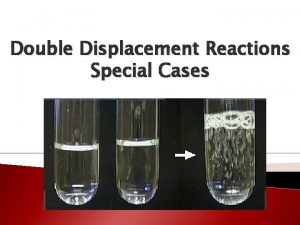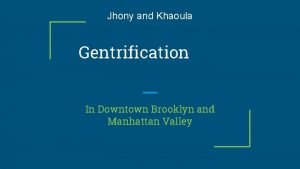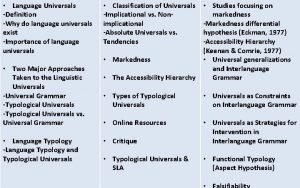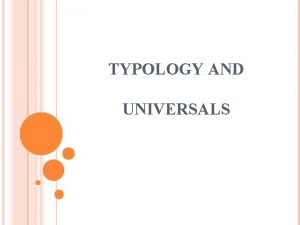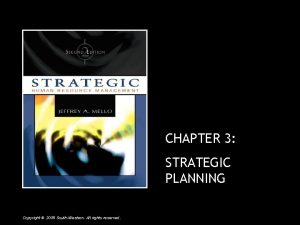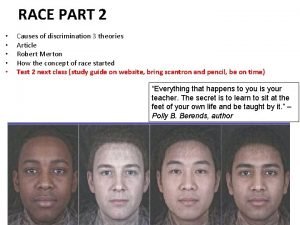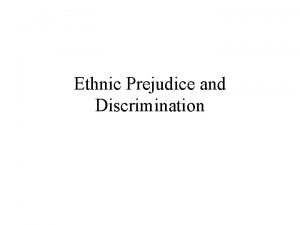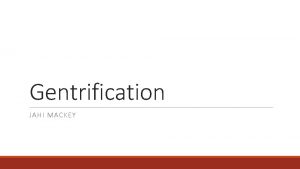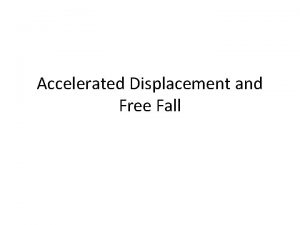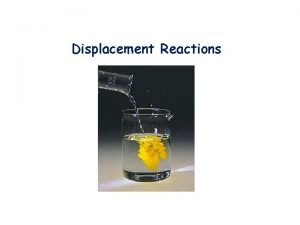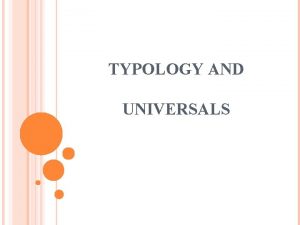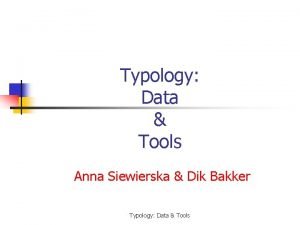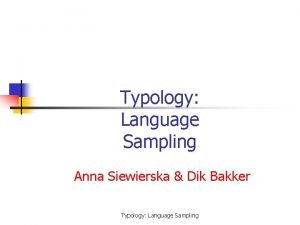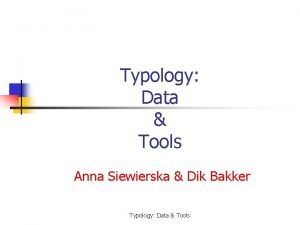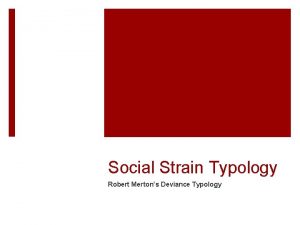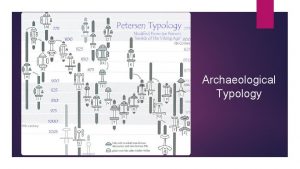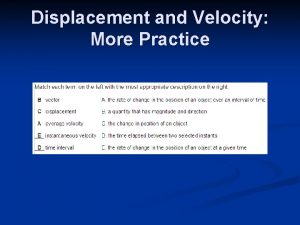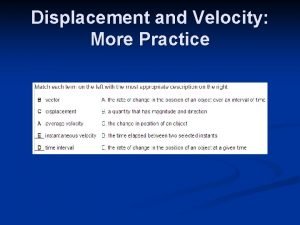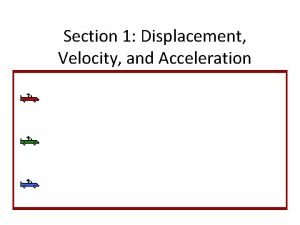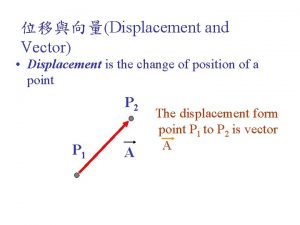Gentrification and displacement typology assessment Presented to East
























- Slides: 24

Gentrification and displacement typology assessment Presented to East Portland Action Plan Ec. Dev Subcomittee April 2, 2018

Definitions • Gentrification: an under‐valued neighborhood that becomes desirable, resulting in rising property values and changes to demographic and economic conditions of the neighborhood. These changes include a shift from lower‐income to higher‐income households, and often there is a change in racial and ethnic make‐up of the neighborhood’s residents and businesses. • Displacement: households or businesses involuntarily forced to move from a neighborhood because of increasing market values, rents, or changes in the neighborhood’s ability to meet basic needs in the case of households, or erosion of traditional client base in the case of businesses. Gentrification and displacement | 2

Anti-Displacement Policies Policy 5. 15 Gentrification/displacement risk Evaluate plans and investments for the potential to increase housing costs for, or cause displacement of communities of color, low‐ and moderate‐income households, and renters. Identify and implement strategies to mitigate the anticipated impacts. Policy 5. 16 Involuntary displacement When plans and investments are expected to create neighborhood change, limit the involuntary displacement of those who are under‐served and under‐represented. Use public investments to create permanently‐affordable housing and to mitigate the impacts of market pressures that cause involuntary displacement. Gentrification and displacement | 3

Vulnerability, gentrification and displacement Gentrification and displacement | 4

2000 -2010

Operationalizing the definition 1. Vulnerable communities • • Low‐income (<80% MFI) Communities of color Renter households Adults without a four‐year degree Gentrification and displacement | 6

Vulnerable communities

Operationalizing the definition 1. Vulnerable communities • Low‐income (<80% MFI) • Communities of color • Renter households • Adults without a four‐year degree 2. Demographic change 2010‐ 2016 • Decreasing share of vulnerable communities Gentrification and displacement | 8

2000 -2016 Demographic Changes Source: U. S. Census Bureau, Census 2000 and American Community Survey. Prepared by Portland Bureau of Planning and Sustainability. Gentrification and displacement | 9

Demographic change Content title 2010 -2016 Source: U. S. Census Bureau, 2012‐ 2016 ACS 5‐year estimates, Table B 25032.

Operationalizing the definition 1. Vulnerable communities • Low‐income (<80% MFI) • Communities of color • Renter households • Adults without a four‐year degree 2. Demographic change 2010‐ 2016 • Decreasing share of vulnerable communities 3. Housing market condition • Adjacent – low/moderate market, but near a hot or high market • Accelerating – low/moderate market, but quickly appreciating • Appreciated – market appreciated from low/moderate to high Gentrification and displacement | 11

Housing market condition 2017

Operationalizing the definition 1. Vulnerable communities • Low‐income (<80% MFI) • Communities of color • Renter households • Adults without a four‐year degree 2. Demographic change 2010‐ 2016 • Decreasing share of vulnerable communities 3. Housing market condition • Adjacent – low/moderate market, but near a hot or high market • Accelerating – low/moderate market, but quickly appreciating • Appreciated – market appreciated from low/moderate to high Gentrification and displacement | 13

Updated typology 2010 -2016

Seven risk typologies Typology Vulnerable population? Demographic change? Housing market condition Susceptible Yes No Adjacent Early: Type 1 Yes No Accelerating Early: Type 2 Yes Adjacent Dynamic Yes Accelerating Late: Type 1 Yes Appreciated Late: Type 2 Used to be in 2000 or in 2006‐ 10 Yes Accelerating Continued loss Used to be in 2000 or in 2006‐ 10 Increasing share of Appreciated white people and adults with a four‐ year degree Gentrification and displacement | 15

Seven risk typologies Typology Vulnerable population? Demographic change? Housing market condition Susceptible Yes No Adjacent Early: Type 1 Yes No Accelerating Early: Type 2 Yes Adjacent Dynamic Yes Accelerating Late: Type 1 Yes Appreciated Late: Type 2 Used to be in 2000 or in 2006‐ 10 Yes Accelerating Continued loss Used to be in 2000 or in 2006‐ 10 Increasing share of Appreciated white people and adults with a four‐ year degree Gentrification and displacement | 16

Seven risk typologies Typology Vulnerable population? Demographic change? Housing market condition Susceptible Yes No Adjacent Early: Type 1 Yes No Accelerating Early: Type 2 Yes Adjacent Dynamic Yes Accelerating Late: Type 1 Yes Appreciated Late: Type 2 Used to be in 2000 or in 2006‐ 10 Yes Accelerating Continued loss Used to be in 2000 or in 2006‐ 10 Increasing share of Appreciated white people and adults with a four‐ year degree Gentrification and displacement | 17

Seven risk typologies Typology Vulnerable population? Demographic change? Housing market condition Susceptible Yes No Adjacent Early: Type 1 Yes No Accelerating Early: Type 2 Yes Adjacent Dynamic Yes Accelerating Late: Type 1 Yes Appreciated Late: Type 2 Used to be in 2000 or in 2006‐ 10 Yes Accelerating Continued loss Used to be in 2000 or in 2006‐ 10 Increasing share of Appreciated white people and adults with a four‐ year degree Gentrification and displacement | 18

Updated typology 2010 -2016

2000 -2010

2010 -2016

2000 -2010

2010 -2016

Typologies by the numbers Typology Susceptible Population Households Tracts 47, 920 21, 684 12 Early: Type 1 154, 195 57, 395 30 Early: Type 2 1, 958 743 1 Dynamic 64, 111 24, 141 12 Late: Type 1 10, 953 4, 694 3 Late: Type 2 35, 451 14, 033 7 Continued loss 14, 251 5, 991 4 328, 839 128, 681 69 Total Gentrification and displacement | 24
 Single displacement vs double displacement
Single displacement vs double displacement Downtown brooklyn gentrification
Downtown brooklyn gentrification Gentrification ruth glass
Gentrification ruth glass Newark gentrification
Newark gentrification Production cacao
Production cacao East is east and west is west
East is east and west is west East south east wind direction
East south east wind direction Kalahari desert on africa map
Kalahari desert on africa map Word combinations examples
Word combinations examples Typological universals
Typological universals Typology and universals
Typology and universals Typology of adam and jesus
Typology of adam and jesus Dyer and holder typology of strategies
Dyer and holder typology of strategies Merton's typology of prejudice and discrimination
Merton's typology of prejudice and discrimination Merton's typology of prejudice and discrimination
Merton's typology of prejudice and discrimination When is jekyll and hyde set
When is jekyll and hyde set Themes of romeo and juliet
Themes of romeo and juliet How is power presented in ozymandias and london
How is power presented in ozymandias and london Ozymandias imagery
Ozymandias imagery Cause and effect text structure words
Cause and effect text structure words Fire risk assessment east sussex
Fire risk assessment east sussex Typology
Typology Word order typology
Word order typology Typology of mass media audience
Typology of mass media audience Typology
Typology
